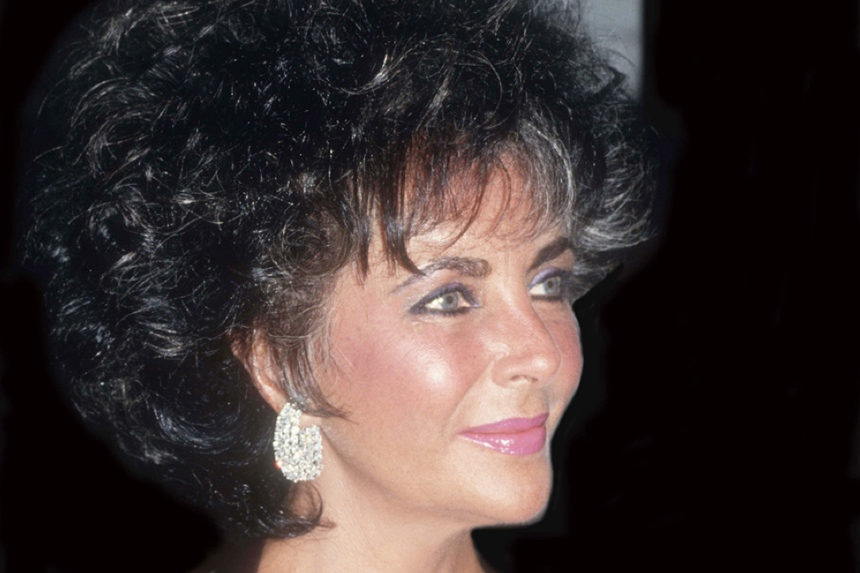In January, many of us pledge to shed excess weight, but as we all know, that’s easier said than done. After my first child was born, I found myself 40 pounds heavier and, after losing half, hit a plateau. The fitness books were filled with hideous prescriptions: counting calories, weighing food, and doing an unpleasant-sounding activity called “reps.”
But I did not want to do any of those things, and the books spooked me. Finally, I stumbled upon one called French Women Don’t Get Fat, by Mireille Guiliano. Its breezy tone assured me that I didn’t have to change my entire personality just to lose weight. A Frenchwoman wouldn’t dream of moving faster than a languid sashay, let alone do “reps.” How absurd!
It was the Francophilic pep talk that I needed, and it got results. But to address the steady upward creep of the scale in my 40s, I need more than the mental image of “being French.”
Enter the American movie star Elizabeth Taylor, one of the most celebrated beauties of all time. Unlike the prototypical Frenchwoman, she did get fat, especially during her marriage to politician John Warner from 1976 to 1982. Stuck at home in Washington, D.C. while Warner worked long hours, Taylor turned to comfort food (and other substances) for solace. “Eating became one of the most pleasant activities I could find to fill the lonely hours and I ate and drank with abandon,” she wrote later.
Taylor was publicly ridiculed for putting on weight in her 40s, but by her 55th birthday was en bonne forme and more glamorous than ever, having “dropped from 180-odd to 122 pounds.” Her 1987 book, Elizabeth Takes Off, tells the story of how she did it and, more importantly, of her extraordinary life. When I saw it in a used bookstore, I pounced on it like a frosted sugar cookie.
Reading the book is like having a vivacious aunt show up at your door, dripping in diamonds, to tell you if she can pull it together, so can you. Born in 1932, Taylor was nine years old when she made her first film, and she spent her childhood working on movie sets. Feisty from the start, in her early teens she told Louis B. Mayer to “go to hell” because she didn’t like the way he spoke to her mother. As a famous young star, she led a sheltered life, guarded by protective parents and studio bosses.
At 17, eager for independence, Taylor entered her first marriage, with seven more to come. Elizabeth Takes Off dwells fondly on her favorite husbands: producer Mike Todd, who died tragically in a plane crash one year after their 1957 wedding; and actor Richard Burton, with whom Taylor shared 11 films and married twice, in 1964 and 1975. She had three children and enjoyed motherhood so much that she adopted a fourth.
“I’ve always admitted that I’m ruled by my passions,” Taylor writes, explaining not just her many marriages but her love of parties, jewelry, and, yes, food. While today’s film actors subsist on soy crumbles and arugula, Liz was a meat-and-potatoes girl who loved burgers, steaks, mashed potatoes, and fries. She once asked a friendly ex-husband to visit her at Dulles Airport during a layover. “And maybe bring some leftover fried chicken. You do have some fried chicken around, don’t you?” Charmed, the ex-husband fried up some chicken and brought it to the airport with a side of fresh corn. And they lived happily ever after.
As she matter-of-factly describes a wild ride of films, marriages, divorces, hospitalizations, and dress fittings, Taylor is a likeable narrator. Despite having owned a giant rock called the Krupp Diamond, she seems an earthy, unpretentious woman with a zest for life. “I confess I love being surrounded by beautiful things and I love being looked after,” she writes (and I confess that I, and every woman strolling the aisles of a Bed, Bath & Beyond, love these things, too).
“When I gained weight, I just bought more clothes,” she writes sensibly. (Nodding.)
When anyone tried to help me, I’d say, ‘Look, I know what I’m doing. I’m going through a phase. I can’t diet until I’m ready, and if you push me, the minute you finish your lecture I will go in and have some hot fudge.’
The minute you finish your lecture, I will go have some hot fudge. I am so using that.
Taylor’s sometimes out-of-control life masked an inner strength, the mental toughness that comes through in her films. After a long run of overeating and other addictive behaviors, she took a hard look in a mirror and didn’t like what she saw. A stint at the Betty Ford Center addressed her alcohol abuse, and with a clear head Taylor realized that she had “been doing a lot of harm to [my] body for an awfully long time . . . . I had actually tossed away my self-respect.”
Husbandless and sober, she came up with her own personal plan for food and exercise. While the first half of Elizabeth Takes Off is autobiography, the second half describes her weight-loss regimen. But first, some general advice: “Get out that full-length mirror,” she instructs in her best bossy-aunt manner. “When you’re trying to diet, it’s no time to play games.” Taylor also advises to “look your best while losing.” She continues:
I know plenty of big ladies who are positively glorious-looking. They may wear a size sixteen or eighteen, but they’re always well groomed, neatly coiffed, and radiantly glamorous. Yet many dieters will throw on anything as long as it’s dark in color. Their philosophy is ‘I’m fat so it doesn’t matter how I look.’ Rubbish. It always matters how you look.
It always matters how you look. Strong words for my drawerful of ratty black yoga pants, Liz! But I hear you.
The diet itself is a curious artifact of the mid-’80s. Breakfast is fruit and whole-wheat toast or a bran muffin; lunches feature low-fat cottage cheese and skinless chicken breasts; and coffee is lightened with “a splash of skim milk.” For someone who liked her hot fudge sundaes, the menu is extremely disciplined, coming in at 1,000-1,200 calories a day. Desserts include a baked apple and something called an orange soufflé, made with “3 tablespoons low-cal margarine,” “2 packets artificial sweetener,” and grated zest.
Even at 30 years’ distance, it’s hard to criticize this diet, though it includes odd items like “barbequed squab” and not one, but two, types of “curried mayonnaise.” If Elizabeth Taylor happily consumed such foods on a tufted divan in her orchid-filled Bel Air estate, with a cabinet of acting awards to her right and an original Renoir to her left, planning her next charity ball on a gold phone, who are we to say Curried Mayonnaise #2 and a tray of raw broccoli is not quite up to par in 2020?
And anyway, you don’t read Elizabeth Takes Off for the recipes. It’s just inspiring to spend 200-plus pages with Aunt Liz, who hastens to add that her low-fat diet allows for occasional “pig-outs,” as she puts it with typical bluntness.
“Guard the assets you were blessed with like a miser,” Taylor instructs, but in the end, she is not unduly obsessed with beauty or weight. “Happily,” she wrote in her 50s, “God made me incredibly resilient and I was able to bounce back. In fact, when someone recently asked me what was my proudest accomplishment, I said with all sincerity: ‘Just being alive.’”
Featured image: Elizabeth Taylor in 1987 (Photo By John Barrett/PHOTOlink.net/MediaPunch/Alamy)
Become a Saturday Evening Post member and enjoy unlimited access. Subscribe now




Comments
Thank YOU Ms. Sinha for this great article! I’m sure Elizabeth herself would have enjoyed it as well, in combination with my comments. I meant every word of it, and wanted them to be something any and all of her admirers would like as well, including her family should they see the feature now or at a later date.
One thing I didn’t mention in Ms. Taylor’s needing rehab (for drugs and alcohol) in large part, was trying to relieve the terrible back pain she suffered going back to the filming of ‘National Velvet’ in 1944 where she sustained the back injuries that would be with her for life, though she hid it well, and didn’t let it let it get in her way. There were times though when it understandably got to be too much, and she wisely sought the help she needed.
This is entirely different from “celebrities” going into “rehab” taking drugs and alcohol for recreational “highs”. This was NOT the case here at all, just as it was not with Betty Ford herself, who founded the famed Rancho Mirage Center for people that got in over their heads trying to alleviate their pain and suffering, knew they needed help, and were willing to do whatever it took to get well again.
Both of these women are shining examples of what rehabilitation IS, and is supposed to be in its original meaning and goal; not a place for celebrities to “hide out” until a media storm around them dies down to focus on something/someone new.
Betty Ford, a particular favorite First Lady of mine, showed what serious effort and determination could do, and did for her. Later, Elizabeth Taylor. Getting help when you need it is a sign of strength and determination, never weakness. Though both women are gone from this life now, let their strengths in these regards live on and on as inspiration, and give hope to all women and men who can benefit from their stories, guidance, perseverance and success for application to their own lives.
Let their heavenly lights shine down upon those who need it most; who feel all hope is gone, and be enveloped with HIS light for full potential. Let these comments of healing go forth into the universe reaching those to whom need it most, no matter how close or far, be it immediately or hundreds of years from now. Let it be said, let it be done. Amen.
Thanks for this great comment, Bob!
What an inspiring, entertaining and delightful article you’ve written here on the one-and-only Elizabeth Taylor, with yet another side of her sheer will to overcome any (and I do mean any) of life’s obstacles thrown her way, of which there were many.
We see her in 1977 on an American Gothic style Post cover not long after her marriage to Senator Warner where the farm isolation took its toll as described, but also saw Ms. Taylor use every fiber in her being to overcome it, giving her 1958 self in ‘Cat On A Hot Tin Roof’ a run for her money in 1987, as seen above. Quite a feat. I think Big Daddy would agree.
She wasn’t afraid of getting into rehab as needed later on at the Betty Ford Center. In 1992 on her 60th birthday, she once again looked and felt her best in a delightfully fun and candid appearance on one of Johnny Carson’s final ‘Tonight Show’ episodes. She also appeared on the February ’92 cover of LIFE, in arguably one of the most beautiful of her MANY covers for them.
Like the diamond in the moonlight she always was and will be, she launched her ‘White Diamonds’ perfume in ’93, with the perfect exotic, sexy and mysterious elements that have kept the fragrance and TV commercials classics to this day.